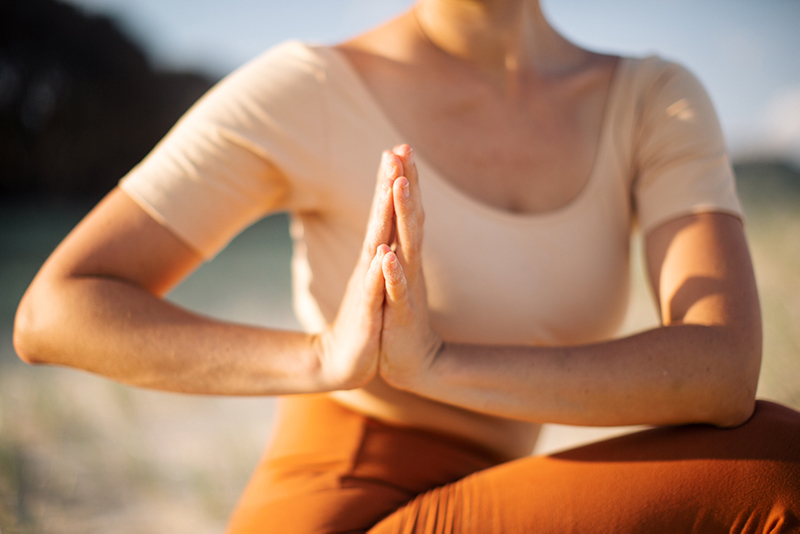Bedtime Meditations for Better Sleep
For many of us, the day doesn’t seem to stop until the minute our head hits the pillow at night. In that precious moment, we think our refuge has finally arrived but we close our eyes and sleep couldn’t seem farther away. Our mind won’t stop chattering. The aches in our body feel more vivid than ever. We start to wonder just how long it will take to fall asleep or whether we’ll get a good night’s sleep at all.
This common scenario is a symptom of our body stuck in the sympathetic nervous system, our fight or flight mode. We need this part of our nervous system as it gives us the adrenaline we need to survive in the world – which these days is more about waiting in lines, dealing with traffic, meeting deadlines, paying our bills, getting the children to school than fighting off an attack from a tiger.
However, when it comes to falling asleep, we need our body to switch to our parasympathetic nervous system, our rest and repair mode. In an ideal scenario, our bodies can easily switch back and forth between the two modes, the way we can flick a light on and off. Because we spend so much of our day in our sympathetic mode, it can be difficult to switch over to the parasympathetic mode on demand.
Here’s where meditation comes in. By tuning into our breath or using a mantra in meditation, we are gently coaxing the body to relax. This then signals to the body that there is no more danger and no need to be alert. In other words, the sympathetic nervous system can hibernate, and the parasympathetic system can come online. Once your body can make that switch into the parasympathetic mode, those elusive Zzz’s happen with ease.
If you’re new to meditation or the word makes you run for the hills, feel free to erase that word and call it a relaxation exercise instead. The ones below are fairly simple. It’s best to do them either in bed or sitting close to the bed, so that you can easily transition to sleep afterwards. Before you start, put away any computers and smart phones so that you’re not tempted to check them in that transition to sleep.
Meditation One: BREATH & BODY SCAN
Lie down on your back and start by taking a few deep breaths. Inhale through your nose, and open your mouth to exhale. Do this three times and as you breathe, notice what the movement of the breath feels like in your body. Can you feel any movement in your belly? Your ribs? Your chest? Try not to judge the movement, and simply observe it.
See if you can make the exhale slightly longer than your inhale. Count your inhale to 3 and exhale for a count of 4 or 5. Do this for another 3 rounds. When you’re working with the breath, the key is to be completely relaxed and not add any tension to the body. If the breath count doesn’t work for you, feel free to skip this part or add it in after a few nights when you’re more comfortable.
Now begin the body scan to help relax the entire body. As you move through the body, repeat a 4 step method for each body part.
1 – Notice any sensations in that body part
2 – Contract any of the muscles in that area for 2 seconds and then release
3 – Mentally allow yourself to release tension in that body area. Say to yourself “My {body part} is relaxed” for e.g. “My hips are relaxed”
4 – Notice again the sensations in that body part
Scan through the following areas of the body. Start at the feet & ankles, moving up to the legs (calves, knees, thighs), buttocks and hips, belly, back, chest, shoulders & neck, and finishing up with the face & the whole head.When you finish your body scan, say to yourself “My whole body is relaxed.”
Meditation Two: CLEAR YOUR MIND
At the end of a long busy day, it can be all the things we didn’t get to that can keep us up at night. I like to flip the switch on the to-do list and instead focus on the things that went well. Going to bed with a positive mindset and feelings of contentment can improve the quality of your sleep.
Get out a piece of paper or your journal and a pen. Write down your 3 main priorities for the next day. Then write down 3 things that you’re proud of or that you’re grateful for that happened today.
Put the paper away, and dim or turn off the lights. Then find a comfortable seat on a cushion, close to your bed. Tune into your breath and notice the breath moving in and out of your body. Gently place one of your hands on your forehead and the other on the top of your head. Breathe into your hands and say to yourself “Tomorrow is another day.” Repeat the mantra 3-5 times.
Next, place both of your hands on your heart space. Again breathe into your hands. This time say to yourself “I am proud of / grateful for {insert one of the things you wrote down}”. Do this for each of the 3 things you wrote down.
As you focus on the positive from your day, notice if that creates a feeling of relaxation in your body or some spaciousness in your mind. Try to hold on to this feeling as you make your way into bed. If your to-do list creeps up again, try not to get frustrated. You can repeat the meditation even after you get into bed.
Meditation Three: WAKE UP RESTFUL
Sometimes the anxiety over whether we’ll get a good night sleep can be what keeps us up at night. What a catch 22. In this scenario, it can be helpful to visualize waking up restful. This meditation can be done sitting up or lying down.
Start by taking 3 deep breaths to help calm yourself. Then start to paint a picture in your mind of waking up feeling energized and restful. Begin by noticing the details of your bedroom. It helps to imagine a peaceful scene. For example, even if the room is messy when you go to bed, in your scene the room can be uncluttered and tidy. Notice the sun gently streaming through the windows to wake you up, and any other details of the room (maybe photos of loved ones or paintings) that make you feel happy.
Then see yourself in your bed, opening your eyes and taking a gentle stretch. What can you hear or smell? What can you feel on your skin? Go ahead and imagine the most restful scene that you’d like to wake up in – even if it means the most luxurious sheets, the smell of fresh flowers, and the birds chirping (in other words not the sound of your children screaming or the neighbor mowing the lawn). This is your safe haven and there’s no limit here to your imagination.
Then take your awareness to your body and notice the internal sensations. What would it feel like to wake up feeling great in your body – what sensations would be there? Which sensations would be gone? What does it feel like to not wake up in a panic or in a rush to get out of the house? Feel a smile on your face as you wake up looking forward to the day. Take your time as you create this scene and linger here for as long as you wish.
When you’re ready to end the meditation, say to yourself “I sleep well and wake up restful and energized.”With this meditation, there’s an added bonus of bringing details from our subconscious mind to our conscious mind of simple changes we could make to our bedroom or waking- up-ritual to improve our quality of sleep. If great ideas coming up during this visualization, jot them down and delay taking action on them until the next day. That way you can stay in the relaxation mode and let the power of your mind ease your way into a restful sleep.



